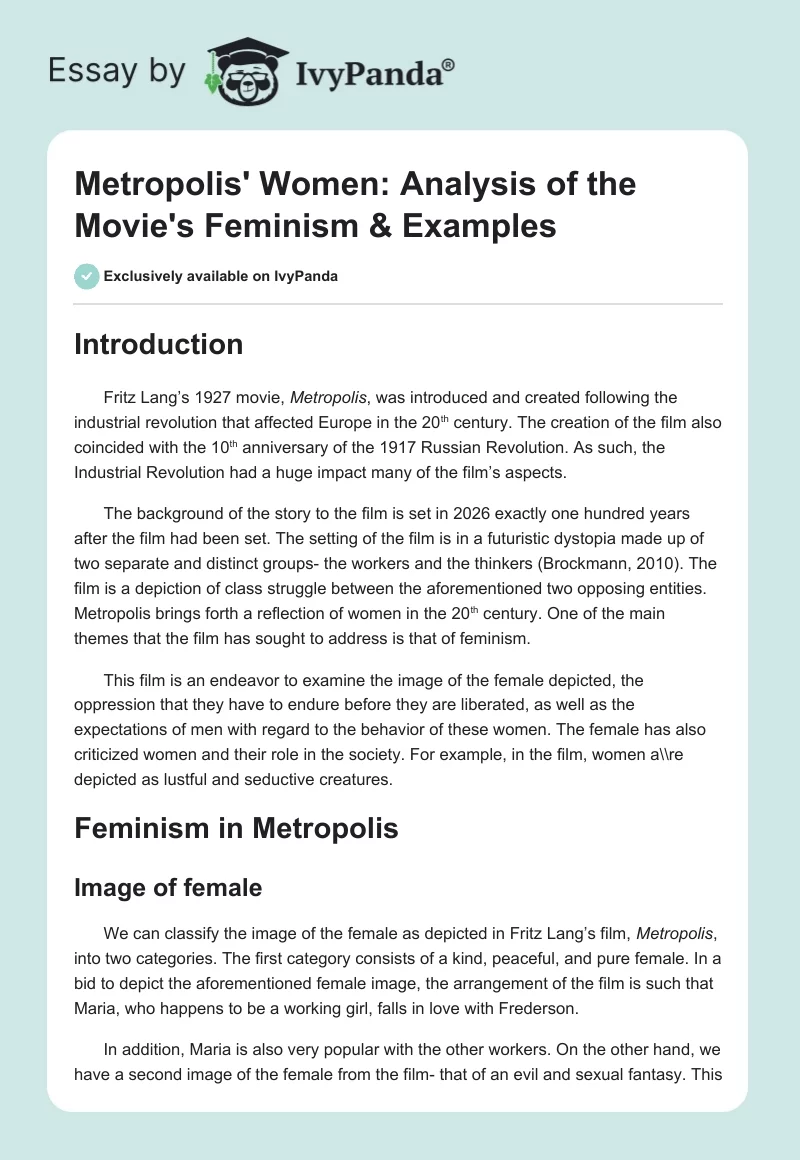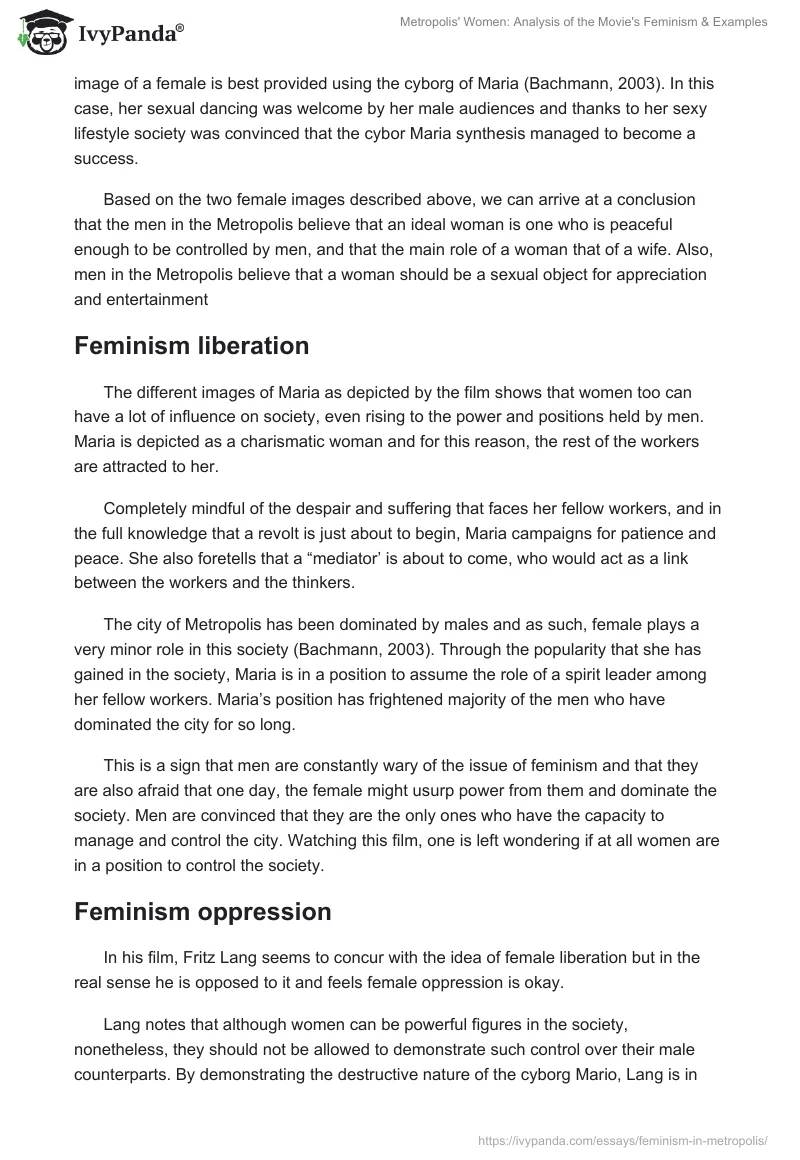Introduction
Fritz Lang’s 1927 movie, Metropolis, was introduced and created following the industrial revolution that affected Europe in the 20th century. The creation of the film also coincided with the 10th anniversary of the 1917 Russian Revolution. As such, the Industrial Revolution had a huge impact many of the film’s aspects.
The background of the story to the film is set in 2026 exactly one hundred years after the film had been set. The setting of the film is in a futuristic dystopia made up of two separate and distinct groups- the workers and the thinkers (Brockmann, 2010). The film is a depiction of class struggle between the aforementioned two opposing entities. Metropolis brings forth a reflection of women in the 20th century. One of the main themes that the film has sought to address is that of feminism.
This film is an endeavor to examine the image of the female depicted, the oppression that they have to endure before they are liberated, as well as the expectations of men with regard to the behavior of these women. The female has also criticized women and their role in the society. For example, in the film, women a\re depicted as lustful and seductive creatures.
Feminism in Metropolis
Image of female
We can classify the image of the female as depicted in Fritz Lang’s film, Metropolis, into two categories. The first category consists of a kind, peaceful, and pure female. In a bid to depict the aforementioned female image, the arrangement of the film is such that Maria, who happens to be a working girl, falls in love with Frederson.
In addition, Maria is also very popular with the other workers. On the other hand, we have a second image of the female from the film- that of an evil and sexual fantasy. This image of a female is best provided using the cyborg of Maria (Bachmann, 2003). In this case, her sexual dancing was welcome by her male audiences and thanks to her sexy lifestyle society was convinced that the cybor Maria synthesis managed to become a success.
Based on the two female images described above, we can arrive at a conclusion that the men in the Metropolis believe that an ideal woman is one who is peaceful enough to be controlled by men, and that the main role of a woman that of a wife. Also, men in the Metropolis believe that a woman should be a sexual object for appreciation and entertainment
Feminism liberation
The different images of Maria as depicted by the film shows that women too can have a lot of influence on society, even rising to the power and positions held by men. Maria is depicted as a charismatic woman and for this reason, the rest of the workers are attracted to her.
Completely mindful of the despair and suffering that faces her fellow workers, and in the full knowledge that a revolt is just about to begin, Maria campaigns for patience and peace. She also foretells that a “mediator’ is about to come, who would act as a link between the workers and the thinkers.
The city of Metropolis has been dominated by males and as such, female plays a very minor role in this society (Bachmann, 2003). Through the popularity that she has gained in the society, Maria is in a position to assume the role of a spirit leader among her fellow workers. Maria’s position has frightened majority of the men who have dominated the city for so long.
This is a sign that men are constantly wary of the issue of feminism and that they are also afraid that one day, the female might usurp power from them and dominate the society. Men are convinced that they are the only ones who have the capacity to manage and control the city. Watching this film, one is left wondering if at all women are in a position to control the society.
Feminism oppression
In his film, Fritz Lang seems to concur with the idea of female liberation but in the real sense he is opposed to it and feels female oppression is okay.
Lang notes that although women can be powerful figures in the society, nonetheless, they should not be allowed to demonstrate such control over their male counterparts. By demonstrating the destructive nature of the cyborg Mario, Lang is in essence arguing that feminism could impact on the society negatively. As such, we need to oppress females. Such a viewpoint is also a suggestion that women do not have a right to hold onto power.
If they did, it would have negative implications on society. This scene is best depicted by the irrational scene of robot Maria who is seen agitating on the workers’ emotions, which resulted in the flooding and eventual destruction of the city. Lang seems to suggest that only men are in a position to solve the problems that the female has created in the society
Female deprecation
In designing the robot in this film, the filmmakers indented to have both the female and the robot share the same identity. This is a sign that the female and the cyborg are both indifferent in the eyes of men, and that the role that omen occupy in society can be taken over by the cyborg.
Consequently, this action deprecates the female to a great deal and is a sign that the female lacks a rational mind, knowledge, and self-thinking. Further, the film suggests that only men can control the female and as such, she should be ready to submit to men.
Male’s expectation of the female
The moviemakers have turned Maria into a cyborg, a neuter and asexual being that do not require being “born” by the female. The cyborg also enables men to construct a new “life” on their own. The idea of a cyborg is in sharp contrast to the expectations of society about the place and role of a woman in society. In this case, the female is expected to sire children and acts as a mother to them. However, turning Maria into a cyborg appears to have renders these roles useless.
It is also an indication that in the Metropolis city, men have the desire to control their female counterparts completely. It is also a sign that the men have no desire to delegate the power that they hold to the females. Lang has also depicted Frederson as being fearful of the females, and this entails women’s nurturing and emotions (Bachmann, 2003). The robot is viewed as a combination of femininity, sexuality and technology via the male imagination.
The robot has been created with the intention of portraying the fear possessed by men on both women and technology. Machines, nature, and women instill fear in men since they act as a threat to male control and dominance. The female robot has instill fear in men and seems intimidates men on the notion that technology might become so advanced and large to an extent that it may one day span out of control, effectively destroy humanity.
In the film, Frederson feels threatened by Maria due to her nurturing and emotions (Brockmann, 2010). For example, in one of the film’s scenes, we see Frederson heading down the catacombs led by Rotwang so that he may watch Maria preaching a message of peace to her fellow workers.
Clearly, this is an ideal portrayal of male fear over domination by the concept of femininity. Fredeson experience this fear because he lacks the necessary control over the situation at hand as he is ill-informed about the catacombs that also gives him a the film seems to suggest that if at all men are to contain their insecurities regarding their dominance over women, then they have to control theses women.
Conclusion
One of the main themes in Fritz Lang’s 1927 movie, Metropolis, is feminism. The film was set in the 20th century and during this time, male domination was very rampant in the society. Women were relegated to the roles of mothers and wives and they had no say in society. In a bid to depict the control that men had over women, the depiction of Maria as a cyborg goes to show that men viewed women as sexual objects to entertain them and fantasize with.
They view women with seduction and lust and according to the men in Metropolis city women should ideally be peaceful enough to allow their men to control them. The influence and popularity that Maria has gained amongst her fellow workers goes to show that women too can liberate themselves from the oppression and suffering that they have been subjected to at the hand of their male counterparts.
Reference List
Bachmann, H. (2003). Fritz Lang’s Metropolis: Cinematic Visions of Technology and Fear. Rochester, New York: Camden House
Brockmann, S. (2010). A Critical History of German Film. London: Camden House.


